The axial skeleton
1/52
There's no tags or description
Looks like no tags are added yet.
Name | Mastery | Learn | Test | Matching | Spaced |
|---|
No study sessions yet.
53 Terms
Axial Skeleton
Midline of the body, including the vertebral column and ribcage, providing support against gravity, protection, points of attachment for muscles, and locomotion. Made up of flat and irregular bone
Notochord
A long rod of fibrous connective tissue that wraps around a fluid core. First evolved for support and locomotion
Vertebral Column
A series of cartilaginous or bony elements that first evolved to protect the spinal cord and dorsal aorta (blood supply). Now its main function is to provide muscle attachments
Dorsal Arches
Structures resting on the notochord that surround the neural tube. Made up of the neural arch and interneural/intercalary arch
ventral arches
associated with/surround the blood supply/dorsal aorta. Sits on the notochord bottom. Made up of the hemal and interhemal arches.
Centra
The central part of vertebrae that replaces the notochord and serves to anchor and support the arches. Ventral arches expand to form this structure where they meet the notochord
Tetrapod Vertebrae Anatomy
Includes neural spine/spinous process, transverse processes, neural canal, pedicel, and laminae, all contributing to spinal structure and function.
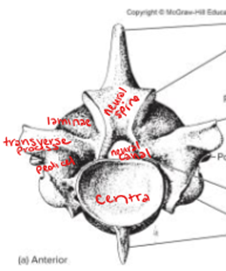
neural spine/spinous process
bumps of the spine
transverse processes
point of attachment for ligaments to muscles or adjacent vertebrae
Neural canal
open space where the spinal cord passes through, completely surrounded and protected by bone
Pedicel
attaches the neural arch to centra
Laminae
attach transverse process to the neural spine
Fish regions of the vertebral column
trunk (body) and caudal (tail). Lack differentiation reflects that it is not used in support, just an elastic beam to support undulating motion. Trunk vertebrae have ribs on them
Amphibian regions of the vertebral column
trunk, caudal, cervical (neck), and sacral (hips). Axial skeleton and musculature retain similarities to fish. Point of attachment is similar to fish
Amniote regions of the vertebral column
Caudal, cervical, sacral, thoracic (back), and lumbar (lower back).
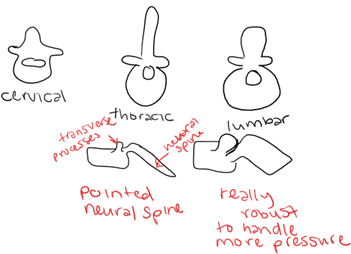
Aspondyly
A condition with no centra, seen in very early vertebrates.
Monospondyly
A condition with a single centra, common in most vertebrates.
Dispondyly
A condition with two centra for a single vertebra, represented in the fossil record.
Polyspondyly
A condition with multiple centra for a single spine, found in holocephali and lungfishes
Aspidospondyly
Primitive vertebrae with separate elements, allowing for flexible movement. Found in primitive tetrapods
Holospondyly
Modern vertebrae with fused elements, providing better support for terrestrial life.
Acoelous
Vertebrae that are flat on each end, resisting compressive forces and helps to maintain shapes. Common in most mammals.
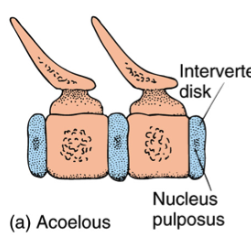
Amphicoelous
Vertebrae with an hourglass shape, concave anteriorly and posteriorly. Solid in modern vertebrates, enhances side-to-side motion, found in many bony fishes, some amphibians and lizard
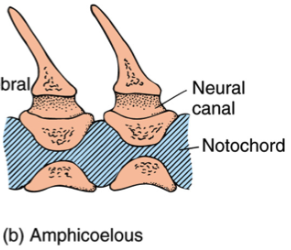
Procoelous
Vertebrae that are concave anteriorly (toward the head), allowing for good movement in any direction, found in frogs and most reptiles.
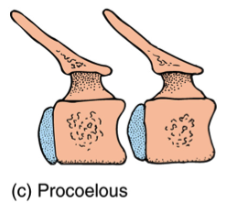
Opisthocoelous
Vertebrae that are concave posteriorly (towards the butt), providing flexibility but also a stable axial column, found in ungulates.
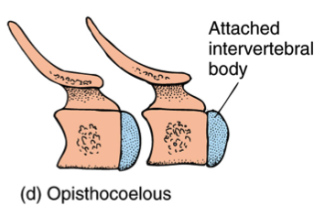
Heterocoelous
Vertebrae shaped like a saddle, concave posterior, convex anterior, allowing for incredible flexibility, seen in cervical vertebrae of birds and turtles.
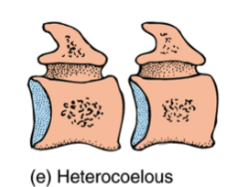
Intervertebral Discs
Pads of fibrocartilage that absorb shock and contain the gel-like remnant of the notochord called the pulposus in the middle of it.
Types of ribs in bony fishes
dorsal and ventral ribs. Homologous with the hemal arches of the caudal vertebrae. Point of attachment for muscle of locomotion
True Ribs
Ribs that connect directly to the sternum ventrally. Costal cartilage goes directly to the sternum
False Ribs
Ribs that articulate with each other but not with the sternum. Costal cartilage joins other costal cartilage, not to the sternum
Floating Ribs
Ribs that do not articulate with anything ventrally. No costal cartilage
Sternum
Midventral skeletal structure providing muscle attachment and protection. Fish do not have one, amphibians have varying sizes of one. Some mammals have it segmented
Parts of the sternum in humans
manubrium, sternabody, and xiphoid cartilage
Ribcage
sternum and ribs (ossified or chondrified) together
Gastralia
Abdominal ribs found in some vertebrates, serving as muscle attachment points. Does not articulate with the vertebrae and are restricted to the ventral body wall. Dermal in origin. Crocodilians and some lizards.
Plastron
A bony plate in turtles that forms the floor of the shell. Fused with clavicles and other skeletal elements, and likely the gastralia
Heterocercal Tail
An asymmetric tail found in chondrichthyans and primitive bony fishes, aiding in buoyancy. Vertebral column turns upward, deep into the dorsal lobe. vertebrae extends deep into the tail. Don’t have lung or air bladders.
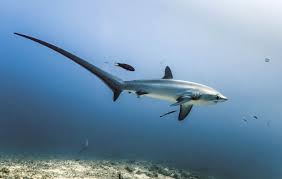
Diphycercal Tail
A roughly symmetrical tail found in lungfishes and coelacanths. Vertebral column extends straight back (symmetry). Coelacanths have 3 lobes
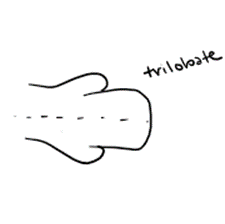
Homocercal Tail
A symmetrical tail found in teleosts, supporting locomotion. Narrowed vertebral column runs to the base and slants upward to support the dorsal edge. Vertebrae terminates at the base of the tail.
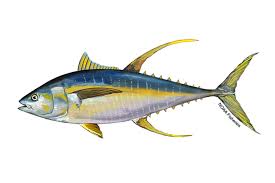
Locomotion transitioning from fish to amphibians
Side-to-side undulation. Fish move in an undulating fashion as a result of side to side flexion. Amphibians have synchronized lateral body swings that both lift the limb and plant the foot (sprawling posture)
Weight bearing stresses adaptions
Terrestrial vertebrates with fused centra for better weight stability, More robust centra to resist compression of the axial skeleton, sacral region with pelvic girdle articulates (joint formation)
Connection between the skull and pectoral girdle was lost, leading to cervical region
better able to feed, surveil surrounding, act as predator, protect the skull from the forces resulting from locomotion
Atlas and Axis
The first two cervical vertebrae (C1 and C2) facilitating head rotation and nodding by acting as a pivot point. Found in amniotes
Atlantoaxial joint
where atlas and axis vertebrate meets
Atlas
named for the greek figure, allows for up and down movement. Skull sits on top of it. Occipital condyle sits on the atlas cavities. Doesn’t have a centra
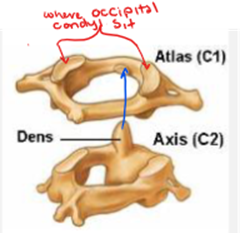
Axis dens
attaches to the atlas, creates side to side motion of the head
Turtles
shell is a composite unit, unique because appendicular skeleton can fit inside axial skeleton. Unclear where the origin of the shell came from
Other reptiles
additional structures prevent torsion (twisting) in snakes but allow for significant lateral bending. Birds have highly mobile vertebrae (heterocoelous) to help with preening and fusion of lower vertebrae to pelvic girdle to make them more aerodynamic.
Mammals
have seven cervical vertebrae (except sloths and manatees), in jumping mammals the cervical vertebrae fuse (ex. armadillos and kangaroo rats), number of thoracic and lumbar vertebrae is variable, caudal vertebrae are reduced compared to reptiles
Form and function
changes in form relate to changes in function
Fluid environment
aquatic organisms do not rely on endoskeleton for support, buoyancy of water does that for them. Have to deal with drag and orientation in 3D space. Axial skeleton is in line, streamlined profile, fins maintain line of travel
Terrestrial environment
Gravity is the problematic force, land animals are either sprawled out against the ground or the body is suspended between the legs. Vertebral column acts as a bridge and the legs are the supports for it to suspend the body and resist compression
Regionalization of Vertebral Column
Differentiation of vertebral regions in various vertebrates, reflecting adaptations to their environments. Reptiles have a reduction of ribs in front of hindlimbs to assist in locomotion and a shift towards more robust centra. Mammals have complex attachment of the musculature to the vertebral column and big, robust centra that has both rigidity and flexibility.